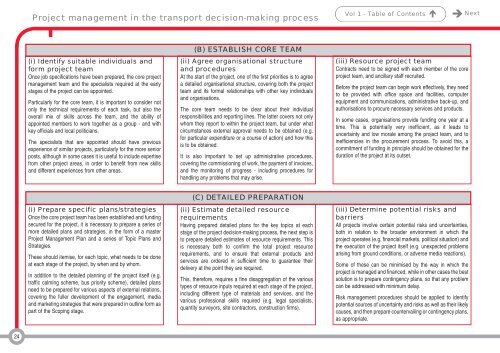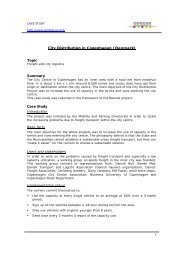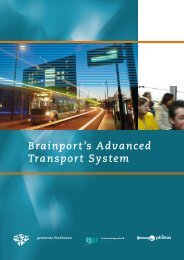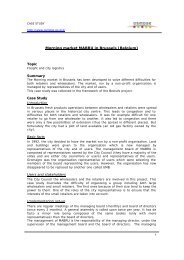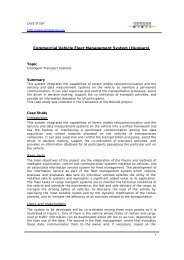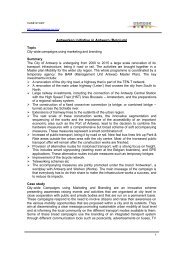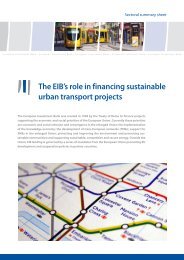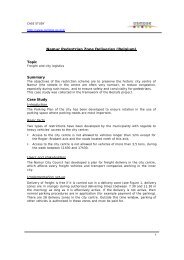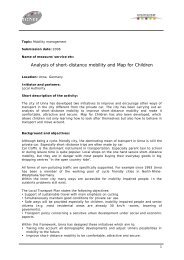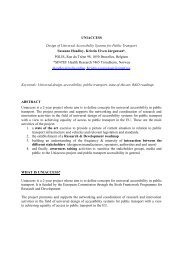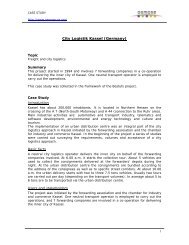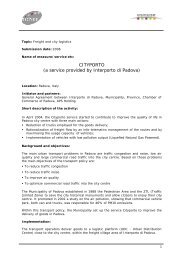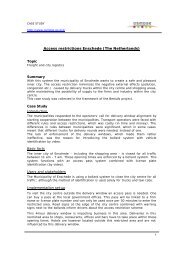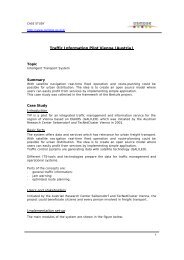Successful transport decision-making - Osmose
Successful transport decision-making - Osmose
Successful transport decision-making - Osmose
Create successful ePaper yourself
Turn your PDF publications into a flip-book with our unique Google optimized e-Paper software.
Project management in the <strong>transport</strong> <strong>decision</strong>-<strong>making</strong> process<br />
Vol 1 - Table of Contents <br />
Next<br />
(i) Identify suitable individuals and<br />
form project team<br />
Once job specifications have been prepared, the core project<br />
management team and the specialists required at the early<br />
stages of the project can be appointed.<br />
Particularly for the core team, it is important to consider not<br />
only the technical requirements of each task, but also the<br />
overall mix of skills across the team, and the ability of<br />
appointed members to work together as a group - and with<br />
key officials and local politicians.<br />
The specialists that are appointed should have previous<br />
experience of similar projects, particularly for the more senior<br />
posts, although in some cases it is useful to include expertise<br />
from other project areas, in order to benefit from new skills<br />
and different experiences from other areas.<br />
(B) ESTABLISH CORE TEAM<br />
(ii) Agree organisational structure<br />
and procedures<br />
At the start of the project, one of the first priorities is to agree<br />
a detailed organisational structure, covering both the project<br />
team and its formal relationships with other key individuals<br />
and organisations.<br />
The core team needs to be clear about their individual<br />
responsibilities and reporting lines. The latter covers not only<br />
whom they report to within the project team, but under what<br />
circumstances external approval needs to be obtained (e.g.<br />
for particular expenditure or a course of action) and how this<br />
is to be obtained.<br />
It is also important to set up administrative procedures,<br />
covering the commissioning of work, the payment of invoices,<br />
and the monitoring of progress - including procedures for<br />
handling any problems that may arise.<br />
(iii) Resource project team<br />
Contracts need to be signed with each member of the core<br />
project team, and ancillary staff recruited.<br />
Before the project team can begin work effectively, they need<br />
to be provided with office space and facilities, computer<br />
equipment and communications, administrative back-up, and<br />
authorisations to procure necessary services and products.<br />
In some cases, organisations provide funding one year at a<br />
time. This is potentially very inefficient, as it leads to<br />
uncertainty and low morale among the project team, and to<br />
inefficiencies in the procurement process. To avoid this, a<br />
commitment of funding in principle should be obtained for the<br />
duration of the project at its outset.<br />
(i) Prepare specific plans/strategies<br />
Once the core project team has been established and funding<br />
secured for the project, it is necessary to prepare a series of<br />
more detailed plans and strategies, in the form of a master<br />
Project Management Plan and a series of Topic Plans and<br />
Strategies.<br />
These should itemise, for each topic, what needs to be done<br />
at each stage of the project, by when and by whom.<br />
In addition to the detailed planning of the project itself (e.g.<br />
traffic calming scheme, bus priority scheme), detailed plans<br />
need to be prepared for various aspects of external relations,<br />
covering the fuller development of the engagement, media<br />
and marketing strategies that were prepared in outline form as<br />
part of the Scoping stage.<br />
(C) DETAILED PREPARATION<br />
(ii) Estimate detailed resource<br />
requirements<br />
Having prepared detailed plans for the key topics at each<br />
stage of the project <strong>decision</strong>-<strong>making</strong> process, the next step is<br />
to prepare detailed estimates of resource requirements. This<br />
is necessary both to confirm the total project resource<br />
requirements, and to ensure that external products and<br />
services are ordered in sufficient time to guarantee their<br />
delivery at the point they are required.<br />
This, therefore, requires a fine disaggregation of the various<br />
types of resource inputs required at each stage of the project,<br />
including different type of materials and services, and the<br />
various professional skills required (e.g. legal specialists,<br />
quantity surveyors, site contractors, construction firms).<br />
(iii) Determine potential risks and<br />
barriers<br />
All projects involve certain potential risks and uncertainties,<br />
both in relation to the broader environment in which the<br />
project operates (e.g. financial markets, political situation) and<br />
the execution of the project itself (e.g. unexpected problems<br />
arising from ground conditions, or adverse media reactions).<br />
Some of these can be minimised by the way in which the<br />
project is managed and financed, while in other cases the best<br />
solution is to prepare contingency plans, so that any problem<br />
can be addressed with minimum delay.<br />
Risk management procedures should be applied to identify<br />
potential sources of uncertainty and risks as well as their likely<br />
causes, and then prepare countervailing or contingency plans,<br />
as appropriate.<br />
24


